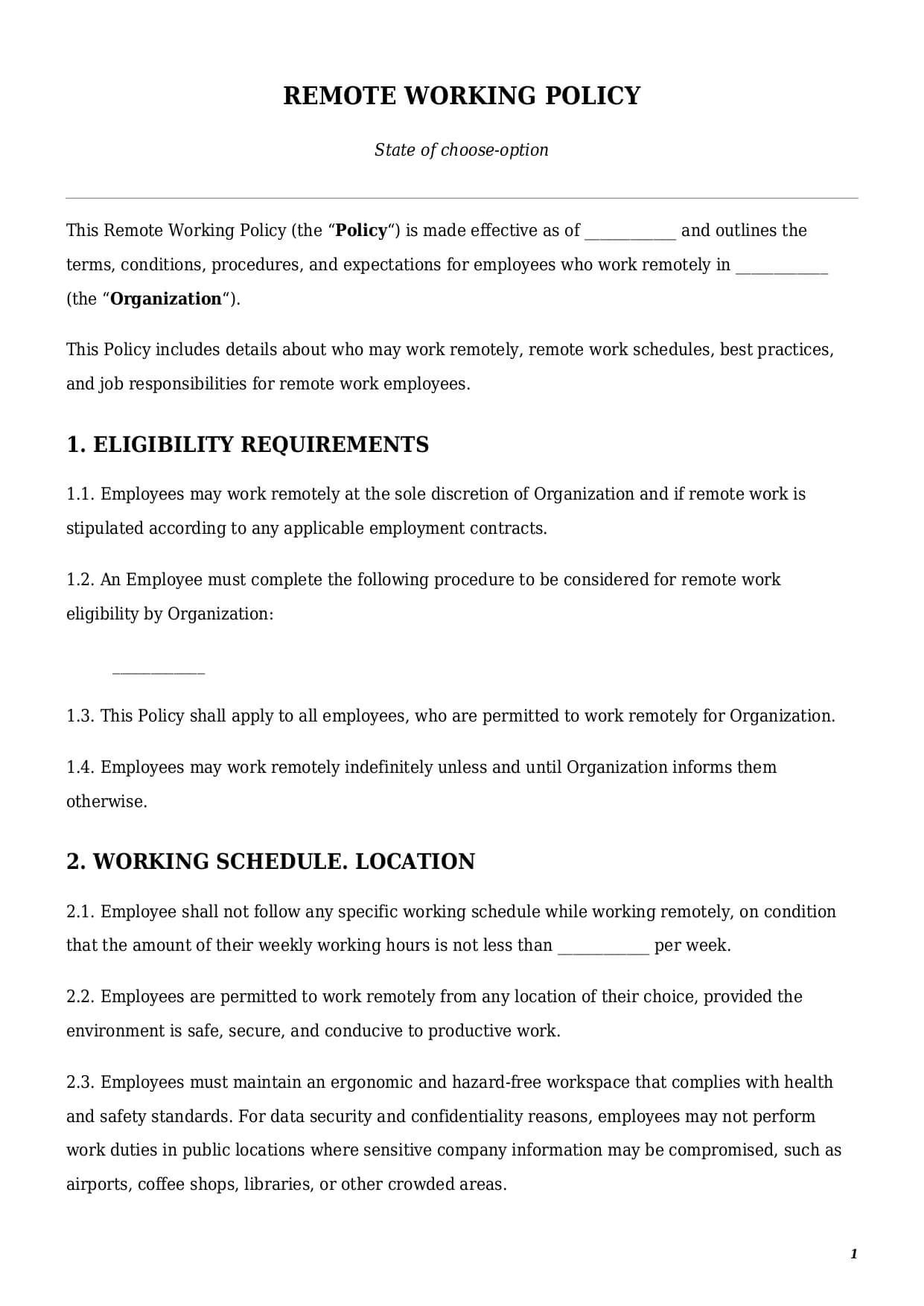Remote Working Policy
Reviews


What is the remote working policy?
A remote working policy is an organization’s internal formal document that sets out the rules, expectations, and responsibilities for employees who work from outside the employer’s physical office. The policy is aimed at defining the following important aspects of remote work:
- scope of application and eligibility;
- working schedule and location;
- communications standards;
- remote working equipment;
- compensation rules (including benefits, expenses, etc.)
A well-drafted sample remote work policy provides a clear roadmap for both employees and managers for defining the remote working arrangement. This policy could be used by any nonprofit organization, company, startup, or business operating within the U.S.
Remote work is a bonus that organizations offer to their employees. Therefore, adoption of a remote working policy is an organization’s right and not an obligation.
This policy is normally used in conjunction with other organizations’ internal corporate policies, including social media policy, employee handbooks, etc.
How to draft a remote working policy template?
Drafting a remote work policy template is a challenging task, as there are a lot of things an organization shall consider prior to allowing their employees to work remotely. Below we made a summary of the most important elements every remote working policy should have:
Eligibility for Remote Work
The most important part of every remote working policy template is to define its scope of application. From the first sight it may appear unnecessary, as remote policy shall apply to all employees within the organization. However, this is not always feasible, as allowing certain departments or positions to operate outside the office may compromise work quality or disrupt overall workflows.
Therefore, when defining the scope of application for remote policy, consider the following:
- Who is a remote employee? A sample remote work policy may apply to employees who work full-time only or may extend its scope of application to part-time employees as well. An organization may also consider inclusion of their interns, volunteers, or contractors into remote working arrangements.
- Who is eligible for remote work? The text of a policy shall also address eligibility criteria for becoming a remote employee. For example, a person may need to first pass a probation period to submit their request for remote work. Or, an organization may wish to grant remote work only to women who wish to stay at home with their kids.
- Who is not eligible for remote work? An organization may also wish to limit certain categories of employees from working remotely. This may be required for a number of reasons, including protection of confidential information, security considerations, inefficiency, etc. For instance, a salesperson in a shopping mall cannot request a remote working arrangement, as they need to sell products on-site.
Finally, the text of the policy shall clarify that remote work is a privilege, not an entitlement, and may be revoked.
Working Schedule and Tracking
Working remotely does not mean the absence of a specific working schedule an employee has to follow. Most remote working policies tend to oblige their remote employees to work the same hours as employees who stay in the office. However, this is not usually the case for remote employees who work in different time zones.
Thus, the text of a working remotely policy template shall address the following important elements:
- exact working schedule (e.g., Monday to Friday from 8 am to 5 pm);
- lunch breaks, including their duration;
- hours during the day within which an employee is online and available for calls and discussions; and
- rules for tracking working hours.
Inclusion of all the provisions mentioned above ensures consistency in the working schedule of employees. On top of that, it makes it easier for an organization’s management to evaluate the performance of remote employees.
Remote Work Equipment
While working remotely, employees may use their own equipment or equipment provided by the organization. In most of the cases equipment for remote employees includes laptops, monitors, mobile phones, headsets, or similar devices. However, depending on the complexity and type of the work performed, it may also include the provision of other additional stationary equipment like printers or scanners.
A well-drafted remote work policy template shall answer the following questions:
- Who provides equipment for remote work?
- If an employee uses their own equipment, how is he or she being compensated?
- If an employee uses an organization’s equipment, how shall this equipment be maintained?
Compensation and Benefits
One of the most important sections every sample remote work policy should have is the compensation and benefits clause. This clause defines the list of benefits a remote employee shall be entitled to. While paying additional benefits or compensation is an organization’s right, rather than an obligation, most companies within the U.S. tend to provide small compensation packages.
A compensation package usually includes a coverage of certain expenses an employee may incur while working remotely. For instance, if an employee works from home, an organization may compensate their monthly electricity or internet bills. Or, if, for example, an employee works remotely from a co-working space, in that case an organization may cover the employee’s expenses for renting out that space.
Benefits for remote employees may not differ significantly from the benefits an employee working in the office shall get. At the same time, inclusion of a precise list of benefits into a sample remote work policy adds clarity for both parties. The benefits may include insurance coverage for an employee and their family members, additional paid days of annual leave, and many more.
Last but not least, a solid remote working policy usually clarifies if a remote employee shall get compensation for overtime work. Overtime work is work outside of normal working hours. Normally, remote employees are being treated equally with employees working at the office. Therefore, as a rule of thumb, remote employees shall get their compensation for working extra hours.
How to customize a remote policy at Faster Draft?
To get a fully customized legal document template, follow a few easy steps below:
- Click the button “Create Document.”
- Answer simple questions in the form.
- Select a document’s format—Remote Work Policy PDF or Word.
- Make a payment.
- Download and use a customized policy in your organization.
Table of content
Frequently Asked Questions (FAQ)
-
1. What is the difference between a remote working policy and an employee handbook?
Both documents have a number of similarities as follows:
- The remote working policy and employee handbook are internal company documents aimed at regulating certain aspects of the organization of the working process.
- The documents are not required by either federal or state law, though most organizations tend to have them.
- Once adopted, documents become legally binding and applicable to all employees working within the organization.
However, there are a number of differences that make both documents independent legal tools.
First, the employee handbook is a more general document that defines all aspects of working “life” within the company. It may include coverage of vacation and leaves, disciplinary rules, code of conduct, compensation and promotion, remote work arrangements, etc. An employee handbook is an internal company’s constitution, which provides superficial regulation of many aspects of the company’s life.
Contrary to that, a remote working policy is a very detailed and specific document that regulates remote working arrangements for employees within an organization. It defines rules, duration, compensation, and other core elements of remote work. Thus, those two documents are complementary to each other but cannot replace each other.
-
2. How to sign a remote working policy template?
There is no legal requirement for an organization to sign a remote working policy template. In the case of an internal organization’s policies, they become legally binding not from the moment of their signing, but from the moment of their acknowledgment by employees.
An employee may acknowledge and agree to the existing policy in a number of ways, including:
- to sing a policy’s copy;
- to tick the box “I agree” or similar on the organization’s intranet;
- by receiving an automatic email informing about the release of a policy.

Looking for something Different?
Start typing to find out our collection of legal documents and contract templates
